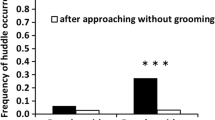Abstract
I analyzed the temporal organization of individual Japanese macaques’ (Macaca fuscata) grooming sequences in 14 mothers and 13 offspring of different age/sex classes and 4 nonkin females. I hypothesized that preceding grooming affects subsequent grooming by the same individual. Grooming bouts were likely to be terminated as the bouts became longer when females groomed nonrelatives. Moreover, the duration of first bouts was longer than that of following bouts. These effects were also seen in grooming of mothers by their offspring > 1 year old and that of adult and adolescent female offspring by their mothers. In contrast, neither the duration of first bouts nor the number of preceding bouts had much effect on the occurrence or duration of subsequent bouts in any subject.
Similar content being viewed by others
References
Altmann, J. (1974). Observational study of behaviour: Sampling methods.Behaviour 49: 227–265.
Barton, R. A. (1985). Grooming site preferences in primates and their functional implications.Int. J. Primatol. 6: 519–532.
Boccia, M. L. (1983). A functional analysis of social grooming patterns through direct comparison with self-grooming in rhesus monkeys.Int. J. Primatol. 4: 399–418.
Boccia, M. L., Rockwood, B., and Novak, M. A. (1982). The influence of behavioral context and social characteristics on the physical aspects of social grooming in rhesus monkeys.Int. J. Primatol. 3: 91–108.
Boccia, M. L., Reite, M., and Laudenslager, M. (1989). On the physiology of grooming in a pigtail macaque.Physiol. Behav. 45: 667–670.
Goosen, C. (1987). Social grooming in primates. In Mitchell, G., and Erwin, J. (eds.),Comparative Primate Biology, Vol. 2B. Behavior, Cognition, and Motivation, Alan R. Liss, New York, pp. 107–132.
Goosen, C., and Metz, J. A. J. (1980). Dissecting behaviour: Relations between autoaggression, grooming and walking in a macaque.Behaviour 75: 97–132.
Haccou, P., and Meelis, E. (1994).Statistical Analysis of Behavioural Data. An Approach Based on Time-Structured Models, Oxford University Press, Oxford.
Hemelrijk, C. K. (1994). Support for being groomed in long-tailed macaques,Macaca fascicularis.Anim. Behav. 48: 479–481.
Hutchins, M., and Barash, D. P. (1976). Grooming in primates: Implications for its utilitarian functions.Primates 17: 145–150.
McKenna, J. J. (1978). Biosocial functions of grooming behavior among the common Indian langur monkeys(Presbytis entellus).Am. J. Phys. Anthropol. 48: 503–510.
Muroyama, Y. (1991). Mutual reciprocity of grooming in female Japanese macaques.Behaviour 119: 161–170.
Muroyama, Y. (1994). Exchange of grooming for allomothering in female patas monkeys.Behaviour 128: 103–119.
Muroyama, Y. (1995). Developmental changes in mother-offspring grooming in Japanese macaques.Am. J. Primatol. 37: 57–64.
Schino, G., Scucchi, S., Maestripieri, D., and Turillazzi, P. G. (1988). Allogrooming as a tension reduction mechanism: A behavioral approach.Am. J. Primatol. 16: 43–50.
Seyfarth, R. M., and Cheney, D. L. (1984). Grooming, alliances and reciprocal altruism in vervet monkeys.Nature 308: 541–543.
Tanaka, I., and Takefushi, H. (1993). Elimination of external parasites (lice) is the primary function of grooming in free-ranging Japanese macaques.Anthropol. Soc. 101: 187–193.
Terry, R. L. (1970). Primate grooming as a tension reduction mechanism.J. Psychol. 76: 129–136.
Trivers, R. L. (1971). The evolution of reciprocal altruism.Q. Rev. Biol. 46: 35–57.
Tsukahara, T. (1990). Initiation and solicitation in male-female grooming in a wild Japanese macaque troop on Yakushima island.Primates 31: 147–156.
Wrangham, R. W. (1982). Mutualism, kinship and social evolution. In King’s College Sociobiology Group, (ed.),Current Problems in Sociobiology, Cambridge University Press, Cambridge, pp. 269–289.
Author information
Authors and Affiliations
Corresponding author
Rights and permissions
About this article
Cite this article
Muroyama, Y. Decision making in grooming by Japanese macaques (Macaca fuscata). Int J Primatol 17, 817–830 (1996). https://doi.org/10.1007/BF02735266
Received:
Accepted:
Issue Date:
DOI: https://doi.org/10.1007/BF02735266




